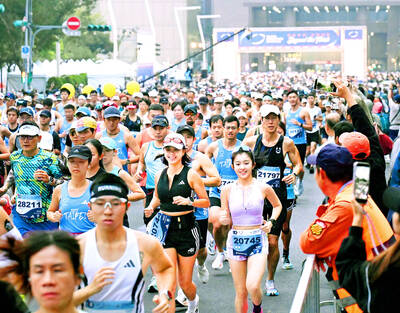Japan's transport minister, Chikage Ogi, is visiting China this week to lobby the government to choose trains built by Japanese companies for a US$16 billion high-speed rail link between Beijing and Shanghai.
Ogi, who arrived in Beijing yesterday, is also meeting officials to promote tourism to Japan. News reports have said China favors Japanese technology for the 1,287km line to shorten travel times between the country's capital and its financial center from 13 hours to less than 5.
Her visit comes after French Trade Minister Francois Loos visited the country in July and lobbied for Alstom SA's Train a Grande Vitesse.
Both Japan's Shinkansen and Alstom's TGV are slower than a train developed by Siemens AG and ThyssenKrupp AG used to link Shanghai and its main international airport, an option the government considers too expensive for the new line.
"The race hasn't finished in favor of the Japanese," Loos said in Beijing, after meeting China's planning and railway ministers on July 25 to lobby for the project.
Mitsubishi Heavy Industries Ltd, Japan's biggest heavy machinery maker, and Kawasaki Heavy Industries Ltd, the country's second biggest, are among suppliers of the 168-mile-per-hour Shinkansen trains, and are part of a group that has said it plans to bid for the project.
Alstom's TGV, which it builds and runs, can travel at 186 miles per hour.
Itochu Corp, Hitachi Ltd, Mitsubishi Corp, Mitsubishi Electric Corp and Nippon Steel Corp are among members of the Japanese group formed in 1995 to bid for the link. Officials declined to comment on the project.
East Japan Railway Co, Japan's biggest railway company, West Japan Railway Co, and Central Japan Railway Co, which operate the trains, are also promoting the technology.
The project is one of a number of large infrastructure works planned to ensure China's economic growth doesn't get stymied by the lack of roads, rails and services.
The world's biggest dam, the Three Gorges Dam, built to control flooding on the Yangzte River and produce power, started filling up in July.
The Chinese government will run a record 320 billion yuan (US$39 billion) budget deficit this year because of increased public works spending.
Among works underway are 176,000 kilometers of new roads around the country and a US$3.3 billion railway from western China's Qinghai province to Tibet.
The Chinese government hasn't said when it will announce the winning bid for the Beijing to Shanghai link.
Officials from the State Development Planning Commission, which is responsible for the project, declined to comment.
A decision on the contracted may be made by November, the Nikkei Weekly newspaper reported today without citing the source of its information.
Ogi is scheduled to meet Chinese Premier Wen Jiabao, Beijing Mayor Wang Qishan, and deputy ministers of the railway and state planning commissions, according to an itinerary provided by the Japanese Embassy in China.
The proposed Beijing-Shang-hai railway will traverse China's two longest waterways, the Yellow River and the Yangtze River, and cut across some of the country's most densely populated provinces.
China already has the world's fastest train, the US$1.25 billion magnetic levitation train built by Siemens and ThyssenKrupp, that started trial runs in May.
The train can travel the 19 miles between Shanghai's Pudong airport and the city's financial center in eight minutes, at a speed of up to 267 miles an hour.
A longer version of the train, called the maglev, will be used to link Shanghai with eastern China's Hangzhou city, cutting the travel time on the 236-mile route to 30 minutes from three hours.
Maglev technology is unlikely to be used to build the Beijing- Shanghai link, because its cost would make it uneconomical, Wu Xiangming, general manager of Shanghai Maglev Transportation Development Co, said.
"From an engineering standpoint, it is feasible to use magnetic-levitation technology to cover the 1,300km from Beijing to Shanghai, but it would come at a huge cost," Wu said.
The is a "50-50 chance" Japan-ese companies will win the contract, Ogi said on July 8, according to an AFP report.

TRAGEDY STRIKES TAIPEI: The suspect died after falling off a building after he threw smoke grenades into Taipei Main Station and went on a killing spree in Zhongshan A 27-year-old suspect allegedly threw smoke grenades in Taipei Main Station and then proceeded to Zhongshan MRT Station in a random killing spree that resulted in the death of the suspect and two other civilians, and seven injured, including one in critical condition, as of press time last night. The suspect, identified as a man surnamed Chang Wen (張文), allegedly began the attack at Taipei Main Station, the Taipei Fire Department said, adding that it received a report at 5:24pm that smoke grenades had been thrown in the station. One man in his 50s was rushed to hospital after a cardiac arrest

SAFETY FIRST: Double the number of police were deployed at the Taipei Marathon, while other cities released plans to bolster public event safety Authorities across Taiwan have stepped up security measures ahead of Christmas and New Year events, following a knife and smoke bomb attack in Taipei on Friday that left four people dead and 11 injured. In a bid to prevent potential copycat incidents, police deployments have been expanded for large gatherings, transport hubs, and other crowded public spaces, according to official statements from police and city authorities. Taipei Mayor Chiang Wan-an (蔣萬安) said the city has “comprehensively raised security readiness” in crowded areas, increased police deployments with armed officers, and intensified patrols during weekends and nighttime hours. For large-scale events, security checkpoints and explosives

PUBLIC SAFETY: The premier said that security would be tightened in transport hubs, while President Lai commended the public for their bravery The government is to deploy more police, including rapid response units, in crowded public areas to ensure a swift response to any threats, President William Lai (賴清德) said yesterday after a knife attack killed three people and injured 11 in Taipei the previous day. Lai made the remarks following a briefing by the National Police Agency on the progress of the investigation, saying that the attack underscored the importance of cooperation in public security between the central and local governments. The attack unfolded in the early evening on Friday around Taipei Main Station’s M7 exit and later near the Taipei MRT’s Zhongshan

A car bomb killed a senior Russian general in southern Moscow yesterday morning, the latest high-profile army figure to be blown up in a blast that came just hours after Russian and Ukrainian delegates held separate talks in Miami on a plan to end the war. Kyiv has not commented on the incident, but Russian investigators said they were probing whether the blast was “linked” to “Ukrainian special forces.” The attack was similar to other assassinations of generals and pro-war figures that have either been claimed, or are widely believed to have been orchestrated, by Ukraine. Russian Lieutenant General Fanil Sarvarov, 56, head